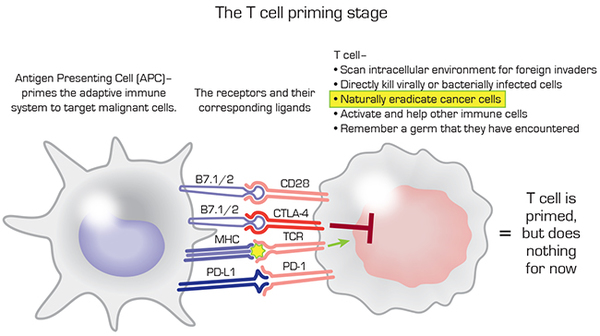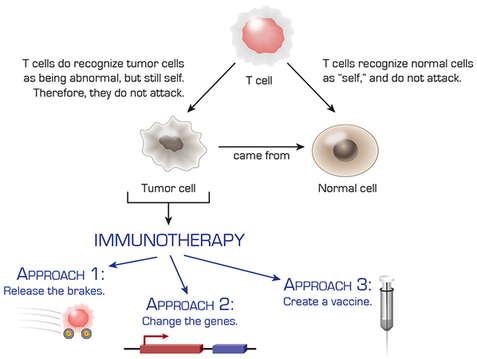FINALLY, I'm ready to talk about the approaches in immunotherapy with Approach 1: Immune checkpoint blockade therapy.
I feel like I’m just about to embark upon listing off all the characters in Game of Thrones...regardless, we’re going to start with a simplified overview of a few key players in immune checkpoint blockade therapy in order to then try to keep track of the various receptors that either activate or reign in these key players.
OK, here we go!
Receptors are these protrusions made of proteins that are embedded on the cell surface, and they basically function to identify and/or interact with what is beyond the cell membrane. Receptors are specific shapes, and sometimes are made up of separate proteins which combine to form a unique receptor. That which binds to a receptor is called a ligand, and some ligands can bind to more than one type of receptor (see B7.1/2 on the APC cells in image). The same type of receptor can also be found on many different kinds of cells, as we’ll see in the next post.
Once a cell has been triggered by a receptor bound by its ligand, that cell will perform its active duties and continue to do so, forever. So what shuts it down? When we’re hungry, for instance, a signal from our satiety center will tell us to stop eating. What then, is that signal for a cell?
The answer: yet another receptor that is bound by its ligand will tell the cell to STOP. With the APC–T cell complex above, this receptor–ligand is the CTLA-4--B7.1/2 pairing. So, as the APC is presenting the antigen from a tumor via its MHC to the T cell, it is simultaneously binding with the T cell’s CTLA-4 receptor to tell it to “HEAL!” But if it encounters that antigen again, it will cut loose.
The T cell then continues along having not been activated. But it has been primed to recognize that antigen.
Next post, let’s get to the heart of checkpoint blockade immunotherapy.
I feel like I’m just about to embark upon listing off all the characters in Game of Thrones...regardless, we’re going to start with a simplified overview of a few key players in immune checkpoint blockade therapy in order to then try to keep track of the various receptors that either activate or reign in these key players.
OK, here we go!
Receptors are these protrusions made of proteins that are embedded on the cell surface, and they basically function to identify and/or interact with what is beyond the cell membrane. Receptors are specific shapes, and sometimes are made up of separate proteins which combine to form a unique receptor. That which binds to a receptor is called a ligand, and some ligands can bind to more than one type of receptor (see B7.1/2 on the APC cells in image). The same type of receptor can also be found on many different kinds of cells, as we’ll see in the next post.
Once a cell has been triggered by a receptor bound by its ligand, that cell will perform its active duties and continue to do so, forever. So what shuts it down? When we’re hungry, for instance, a signal from our satiety center will tell us to stop eating. What then, is that signal for a cell?
The answer: yet another receptor that is bound by its ligand will tell the cell to STOP. With the APC–T cell complex above, this receptor–ligand is the CTLA-4--B7.1/2 pairing. So, as the APC is presenting the antigen from a tumor via its MHC to the T cell, it is simultaneously binding with the T cell’s CTLA-4 receptor to tell it to “HEAL!” But if it encounters that antigen again, it will cut loose.
The T cell then continues along having not been activated. But it has been primed to recognize that antigen.
Next post, let’s get to the heart of checkpoint blockade immunotherapy.



 RSS Feed
RSS Feed
